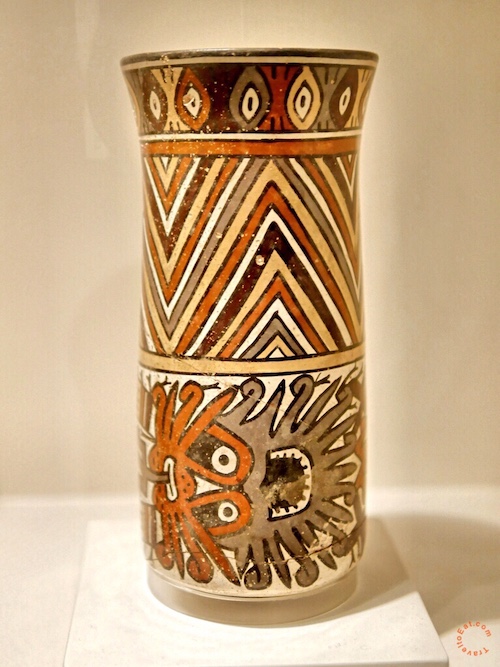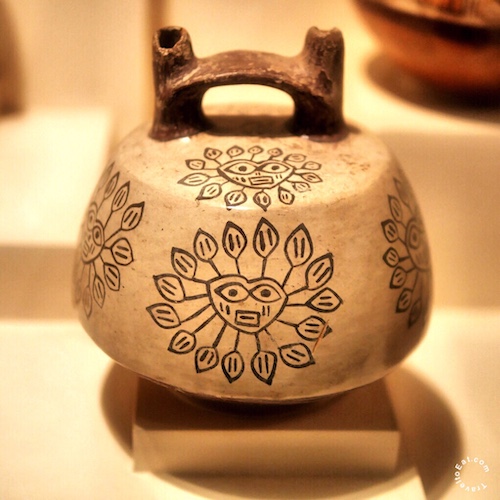
The Nazca culture (also Nasca) was the archaeological culture that flourished from 100 BC to 800 AD beside the dry southern coast of Peru in the river valleys of the Rio Grande de Nazca drainage and the Ica Valley. Having been heavily influenced by the preceding Paracas culture, which was known for extremely complex textiles, the Nazca produced an array of beautiful crafts and technologies such as ceramics, textiles, and geoglyphs (most commonly known as the Nazca lines). They also built an impressive system of underground aqueducts, known as puquios, that still function today. The Nazca Province in the Ica Region was named for this people. From 500 AD, the civilization started to decline and by 750 AD the civilization had fallen completely. This is thought to have occurred when an El Niño triggered widespread and destructive flooding. Evidence also suggests that the Nazca people may have exacerbated the effects of these floods by gradually cutting down Prosopis pallida trees to make room for maize and cotton agriculture. These trees play an extremely important role as the ecological keystone of this landscape: in particular preventing river and wind erosion. Gradual removal of trees would have exposed the landscape to the effects of climate perturbations such as El Niño, leading to erosion and leaving irrigation systems high and dry.

The Nazca civilization flourished on the southern coast of Peru between 200 BCE and 600 CE. They settled in the Nazca and other surrounding valleys with their principal religious and urban sites being Cahuachi and Ventilla, respectively. The Nazca were contemporary with, and then outlasted, the Paracas culture and many Paracas sites have been discovered beneath Nazca settlements. Politically, the Nazca civilization has been described as a collection of chiefdoms occasionally acting in unison for mutual interest rather than as a single unified state. As they developed, the Nazca extended their influence into the Pisco Valley in the north and the Acari Valley in the south. Much of what is known about the Nazca religion comes from their pottery. Their polychrome, or multicolored, pottery came in different shapes such as double spout bottles, effigy forms, and mythical creatures. Since the Nazca had no writing system, iconography painted on pottery served as means of communication and preservation of history. Scenes depicted nature spirits in the form of mythical animals or as anthropomorphic beings. Examples include the mythical killer whale, the mythical spotted cat, and a snake-like creature. Sometimes spirits were depicted as having both human and animal characteristics.

A Nazca drum representing a mythical ancestor who is wearing a headdress with the head of the feline god. In the middle of the ancestor’s chest there is a mythical feline. Two serpents with feline faces emerge from the mouth to envelop the body of the main figure. Among Nazca ceramics, it is the drums which bear the richest iconography. They are loaded with religious symbolism. In Nazca culture, drums and panpipes were used in the ritualprocessions and dances associated with agricultural fertility.




The Nazca culture is characterized by its beautiful polychrome pottery, painted with at least 15 distinct colors. The shift from post-fire resin painting to pre-fire slip painting marked the end of Paracas-style pottery and the beginning of Nazca-style pottery. The use of pre-fire slip painting meant that a great deal of experimentation took place in order to know which slips produced certain colors. Major pottery shapes include double-spout bottles, bowls, cups, vases, effigy forms, and mythical creatures.




Magnum handle peak cintada bridge with anthropomorphic representation of heads heart-shaped leaves with appendages.



This region stretched between the Chincha and Acarí valleys, but the core was between the Ica and Nazca. Michael Moseley, in his superb “The Incas and their Ancestors” (2001 [1992]), estimates that the entire Rio Grande de Nazca drainage, in which all the sites with Nazca material culture have been found, supported no more than 25,000 people in the ancient period (making my hometown of Chandlers Ford nearly the equal of the entire ancient Nazca population). The early core of the Nazca corporate style (as such things are called in Andean archaeology) was centred on Cahuachi, a ritual-ceremonial centre that was interpreted by earlier generations of archaeologists as a bona fide city. It consists of about four square kilometres of pyramids and out-buildings built on natural outcrops, with some enclosures clearly intended for large but temporary congregations of people. Few people lived at the site, and it probably wasn’t the center of a large Nazca state. As always, please leave a comment.
References:
Nazca: http://people.umass.edu/proulx/Nasca_Ceramic_Project.htm
Nasca Culture: http://people.umass.edu/proulx/online_pubs/Nasca_Overview_Zurich.pdf
Nazca: http://www.ancient.eu/Nazca_Civilization/

